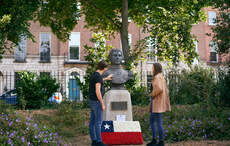Archeologists from Saint Louis University are using unmanned aerial vehicles (UAV) to detect medieval treasures invisible to the eye on land, at Lough Key, County Roscommon.
Using new technology history Professor Thoman Finan, Ph.D plans to piece “together various medieval settlements (high status lordly sites, ecclesiastical sites, lower status agricultural sites) to explain social dynamics and the events of the thirteenth century in particular."
Lough Key is located near the town of Boyle, in County Roscommon. The lake is several kilometres across and contains over 30 wooded islands including Castle Island, Trinity Island, Orchard Island, Stag Island, Bullock Island, and Drumman's Island.
The earliest recorded structure on Castle Island dates back to 1184. In the Annals of Loch Cé, where a lighting strike is reported to have started a fire in "The Rock of Loch-Cé," a "very magnificent, kingly residence." Currently a folly castle built in the early 19th century by the King family stands on the island. Trinity and Church Islands each have the ruins of medieval priories standing on them.
Finan has been working with Paul Naessens, director of Western Aerial Survey and a field archaeologist, to further their exploration through the use of UAVs.
For over 20 years Finan has spent his summer breaks on archaeological digs. Speaking to reporters from St. Louis University he explained how UAV technology, “along with high speed computer applications and mapping software, and sensors that can collect multi-spectral image are changing archaeology”. They believe that this is the “next great jump in archaeological technology.”
For two decades Finan has been exploring the historic riches in north County Roscommon, often accompanied by American students, including the ecclesiastical complex at Kilteasheen, the Rock of Lough Key, the MacDermot moated site stronghold near the Rock, six ringforts (smaller agricultural settlements) and the Kilbrian ecclesiastical site.
He told the University “In 2013-14, we identified what we believe to be a major medieval Gaelic settlement in proximity to the Rock of Lough Key, a stunning island fortification,
"This year, we focused our attention on some lesser known sites in the area, including a ringfort that shows great promise for medieval settlement and what appears to be a major settlement in association with the parish church at Kilbrian."
This survey brings together the latest in archaeological technology to enhance the understanding of the sites.
Finan explained “Most of these sites are found in the inventory of the National Monuments Service, but are often given cursory classification distinctions.
“My interest is piecing together various medieval settlements (high status lordly sites, ecclesiastical sites, lower status agricultural sites) to explain social dynamics and the events of the thirteenth century in particular."
His team uses traditional tools ,such as gradiometry, electrical resistivity and topographical surveys, to identify features in the landscape. The addition of the aerial survey adds a new element to the study.
Through the new surveys they have “collected an unprecedented amount of digital data.
“The 3D landscape data allows us to see minute changes in the topography that can be defined as structures and human occupation. The digital data collected with the geophysics is then wrapped around that 3D data to give us an amazing understanding of what is there without sinking a spade."
The only difficulty to arise from the new survey is the sheer wealth of data. He said the vast amount of data they are collecting fills hard drives quickly.
He said “In reality the management of the data revolves around developing tools that can both archive and present the data in new ways. This is really where the cutting edge of digital archaeology is right now. We have tons of digital data, but what do we do with it?
“From our perspective, we have chosen to make the data freely available to anyone who wants to use it for scholarly purposes with proper attribution using an open-data policy. Our next step is to integrate that database with other archaeological information that has been collected over the years from excavations, archives and even aerial photos from a hundred years ago."




Comments